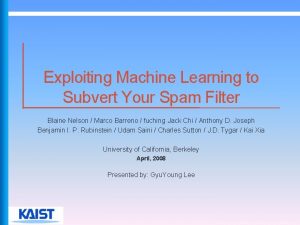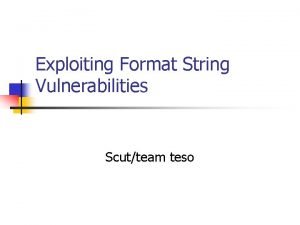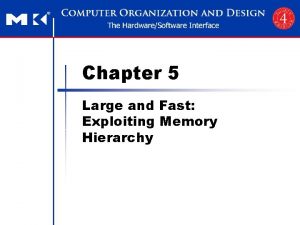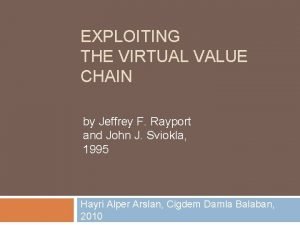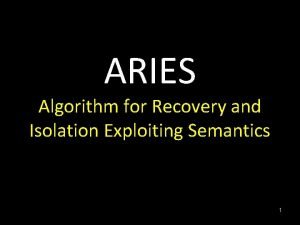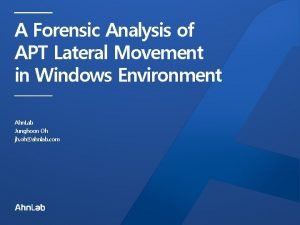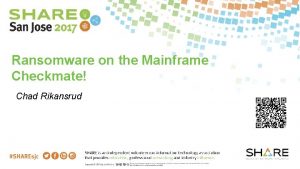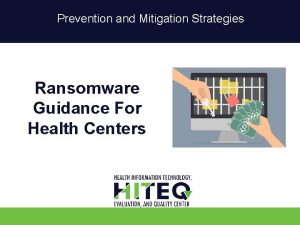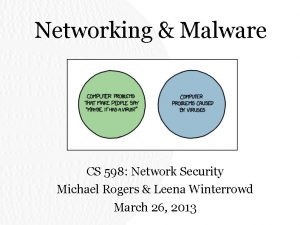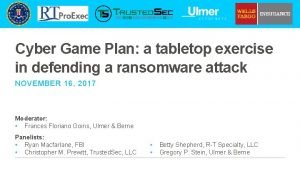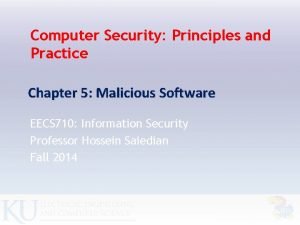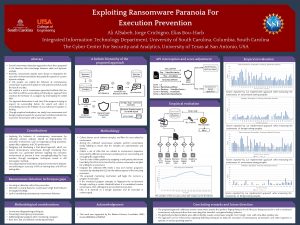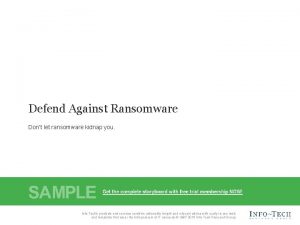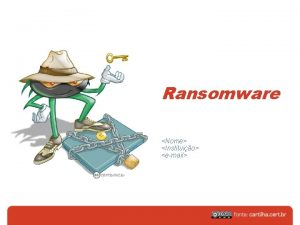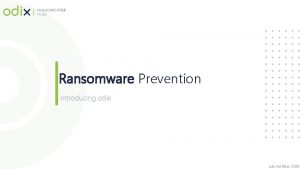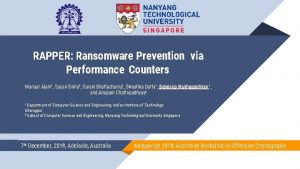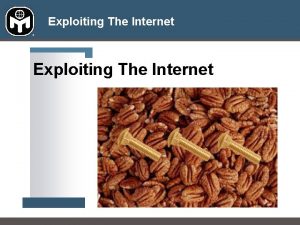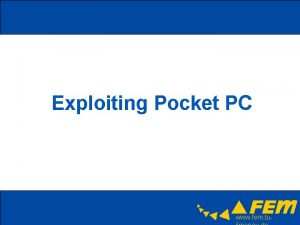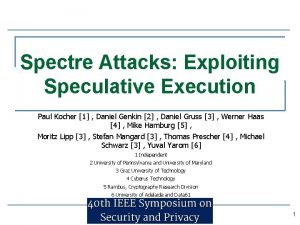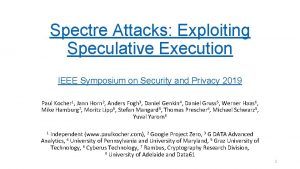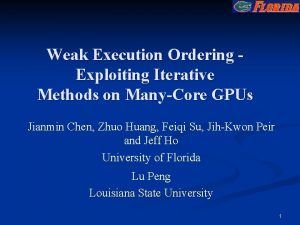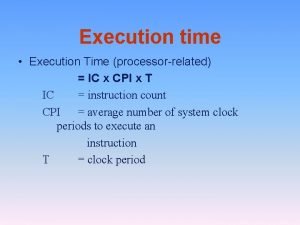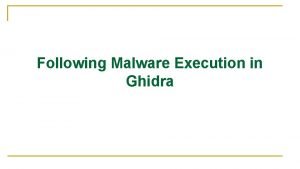EXPLOITING RANSOMWARE PARANOIA FOR EXECUTION PREVENTION Ali Al





























- Slides: 29

EXPLOITING RANSOMWARE PARANOIA FOR EXECUTION PREVENTION Ali Al. Sabeh, Haidar Safa, Elias Bou-Harb, Jorge Crichigno Presented by: Ali Al. Sabeh IEEE International Conference on Communications 2020

OVERVIEW • Introduction • Motivation • Related Work • Problem Statement • Contribution • Proposed Approach • Evaluation and Results • Conclusion and Future Work

INTRODUCTION 3

RANSOMWARE • Increasingly devasting attack • Locks and/or encrypts the victims’ machine • Ask for a ransom to return encrypted data If you don’t pay Lose your data 4 Count on backups If you pay Pay and “hope” to get back your data

MOTIVATION 5

MOTIVATION 6

RELATED WORK 7

ANALYSIS TECHNIQUES • Static analysis does not execute the sample and it is achieved by inspecting: • Source code • Assembly • Executable file… • Dynamic analysis executes the sample in an isolated environment and records the generated activities such as: • File access • Memory access • Registry access 8

RANSOMWARE DETECTION TECHNIQUES • BRIDEMAID • Combination of static and dynamic analysis to detect ransomware in Android operating system • UNVEIL • Detects ransomware by creating an artificial, yet realistic execution environment that can detect file lockers and screen lockers • Net. Converse • Detects ransomware from the generated network traffic using machine learning • Ransom. Flare • Combination of behavioral-based analysis and machine learning to detect ransomware 9

PROBLEM STATEMENT 10

PROBLEM STATEMENT • The previous approaches devote their work to detect a ransomware from the behaviors it generates • However, there is no prevention technique that suppresses the execution of ransomware • In our paper, we work on preventing a contemporary ransomware sample from the environmental artifacts it executes prior to the attack. 11

CONTRIBUTION 12

CONTRIBUTION • Exploring the behavior of contemporary ransomware by collecting relevant artifacts related to fingerprinting the execution environment • Designing and developing a host-based approach which can detect and prevent contemporary ransomware through monitoring their “paranoia” • Executing empirical evaluations using real ransomware datasets • Training: 91% accuracy • Testing: 84% accuracy 13

PROPOSED APPROACH 14

PROPOSED APPROACH Get. Windows. Directory Enum. Printers. W Enum. Services. Status. W C: agent. py System. Bios. Version 15

DATASET COLLECTION • The collected ransomware samples were from multiple sources • The collected samples were inconsistent (file types, compatibility) and they lack metadata • Using Virus. Total API, we did the following: • Performed data cleaning to filter out incompatible samples w. r. t our execution environment • Associated meta-data labels to map each ransomware sample to its corresponding family 16

API MONITORING AND COLLECTING ENVIRONMENT ARTIFACTS • To study the behavior of an application we monitored the called APIs using Microsoft Detour library • The collected APIs were filtered to include the ones mainly related to environment fingerprinting 17

MANAGING FALSE POSITIVES USING PRIORITIZED COLLECTED APIS • To address false positives, the collected APIs were monitored against benign applications • A rank is assigned to each API • The more the API is called by evasive ransomware, the more its rank will be close to 10 • Similarly, the more the API is called by benign applications, the less its rank will be 18

MANAGING FALSE POSITIVES USING PRIORITIZED COLLECTED APIS • Every monitored program will have a score that is initially zero and is incremented by the rank of each called API • Once the score exceeds a threshold, the monitored program is killed 19

EVALUATION AND RESULTS 20

ENVIRONMENTAL SETUP • Our approach is currently designed to operate solely on Windows operating system • The approach was tested on virtual box running Windows 10 with 8 GB of RAM and 50 GB of hard disk space • 117 ransomware samples from • 30 different ransomware families (wannacry, cryptolocker, locky) • 98 benign applications • built-in Windows applications (notepad, chrome, Skype) • Random applications marked as safe by Virus Total 21

ENVIRONMENTAL SET UP 22

TRAINING DATA • During this phase, fingerprinting-related APIs were collected and ranked • The scores of ransomware samples are relatively higher than that of benign samples Ransomware samples 23 Benign samples

THRESHOLD • To differentiate between ransomware and benign samples, a threshold is set • A threshold value of 21 has the best accuracy (91%) in the training data set • This value is used as score limit in the testing phase 24

TESTING DATA • With zero-day ransomware samples, and a threshold value of 21, the accuracy was 84% • False negative rate = 22% • Due to the presence of non-evasive ransomware samples • However, can be detect using a regular IDS 25 Ransomware samples Benign samples

CONCLUSION AND FUTURE WORK 26

CONCLUSION • We addressed evasive ransomware that perform environmental fingerprinting checks • We explored fingerprinting artifacts on CPU, registries, memory… • We performed empirical evaluations and showed that our approach is capable of detecting and preventing evasive ransomware 27

FUTURE WORK • Conduct extensive evaluations on a broader set of samples and evasive APIs • Explore deferring techniques to delay/suppress the execution of contemporary ransomware • Enhance the developed prototype to make it more generic on various operating systems 28

THANKS!
 Primary prevention secondary prevention tertiary prevention
Primary prevention secondary prevention tertiary prevention Alison brabban
Alison brabban 10 up
10 up Paranoia definizione
Paranoia definizione Postmodern literature
Postmodern literature What are the 3 clusters of personality disorders
What are the 3 clusters of personality disorders Dgp week 14 answers
Dgp week 14 answers Démence et paranoïa
Démence et paranoïa Simptome paranoia
Simptome paranoia Exploiting the sponsorship examples
Exploiting the sponsorship examples Exploiting machine learning to subvert your spam filter
Exploiting machine learning to subvert your spam filter Pure-ftpd exploit
Pure-ftpd exploit Large and fast: exploiting memory hierarchy
Large and fast: exploiting memory hierarchy Virtual value
Virtual value Aries recovery algorithm
Aries recovery algorithm New entry in entrepreneurship
New entry in entrepreneurship Axa ransomware
Axa ransomware Elk cloner
Elk cloner Executech ransomware
Executech ransomware Cisco security ransomware
Cisco security ransomware Waikato dhb ransomware
Waikato dhb ransomware Psexesvc.exe ransomware
Psexesvc.exe ransomware Mainframe ransomware
Mainframe ransomware Ransomware mitigation strategies
Ransomware mitigation strategies Rrcc ransomware
Rrcc ransomware Ransomware hrvatska
Ransomware hrvatska Ransomware detection rogers
Ransomware detection rogers Ransomware playbook flowchart
Ransomware playbook flowchart Ransomware tabletop exercise
Ransomware tabletop exercise Morris worms
Morris worms










